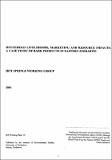| dc.contributor.author | Romero, Claudia | |
| dc.coverage.spatial | Zimbabwe | en_GB |
| dc.date.accessioned | 2014-10-21T12:11:20Z | |
| dc.date.available | 2014-10-21T12:11:20Z | |
| dc.date.issued | 2001 | |
| dc.identifier.citation | Romero, Claudia [et al ] (2001) Effects Of Commercial Bark Harvesting On Adansonia Digitata (Baobab) In The Save Odzi-Valley, Zimbabwe With Considerations For Its Management, IES Working Paper No. 18. Harare, Mt. Pleasant : IES. | en_GB |
| dc.identifier.uri | https://opendocs.ids.ac.uk/opendocs/handle/20.500.12413/4831 | |
| dc.description | An IES study. | en_GB |
| dc.description.abstract | Non-timber forest products (NTFPs) represent a major contribution to rural communities in eastern Zimbabwe. In this area, baobab markets have prospered due to drought and rural poverty. This paper integrates information form related disciplines regarding the baobab ecology, and the baobab bark harvesting, processing, and marketing in the study area of Mutsiyo,. Nhachi and Gundyanga villages (42 km2). Baobab tree densities and size-class distribution were established (8.41 trees/ha), along with the extent of harvesting (99% of individuals sampled had evidence of bark harvesting), and maximum harvested heights (almost 50% of the trees had been harvested up to 2 m). Times of bark and fibre quality regeneration after harvesting were calculated after a 4-year experiment (6 and 10 years to restore pre-harvesting conditions, respectively). An equation was designed to calculate available volumes of and fibre quality of baobab bark, both coming from regenerated scars and non-harvested sections of trees. A discussion is presented regarding the sustainability of the baobab harvesting practice. Ideas for the sustainable use of the baobab bark resource are outlined, based on the concepts of adaptive and community based management. | en_GB |
| dc.description.sponsorship | Funding for the study was provided by Canadian International Development Agency (CIDA) through the Agroforestry Southern Africa project and the World Wide Fund for Nature (WWF) People and Plants Initiative | en_GB |
| dc.language.iso | en | en_GB |
| dc.publisher | Institute of Environmental Studies (IES) ; University of Zimbabwe.l | en_GB |
| dc.relation.ispartofseries | IES Working Paper Series.;Paper No. 18. | |
| dc.rights.uri | http://creativecommons.org/licenses/by-nc-nd/3.0/ | en_GB |
| dc.subject | Agriculture | en_GB |
| dc.subject | Environment | en_GB |
| dc.subject | Rural Development | en_GB |
| dc.title | Effects Of Commercial Bark Harvesting On Adansonia Digitata (Baobab) In The Save Odzi-Valley, Zimbabwe With Considerations For Its Management | en_GB |
| dc.title.alternative | Household Livelihoods, Marketing And Resource Impacts: A Case Study Of Bark Products In Eastern Zimbabwe | en_GB |
| dc.type | Series paper (non-IDS) | en_GB |
| dc.rights.holder | University of Zimbabwe | en_GB |


